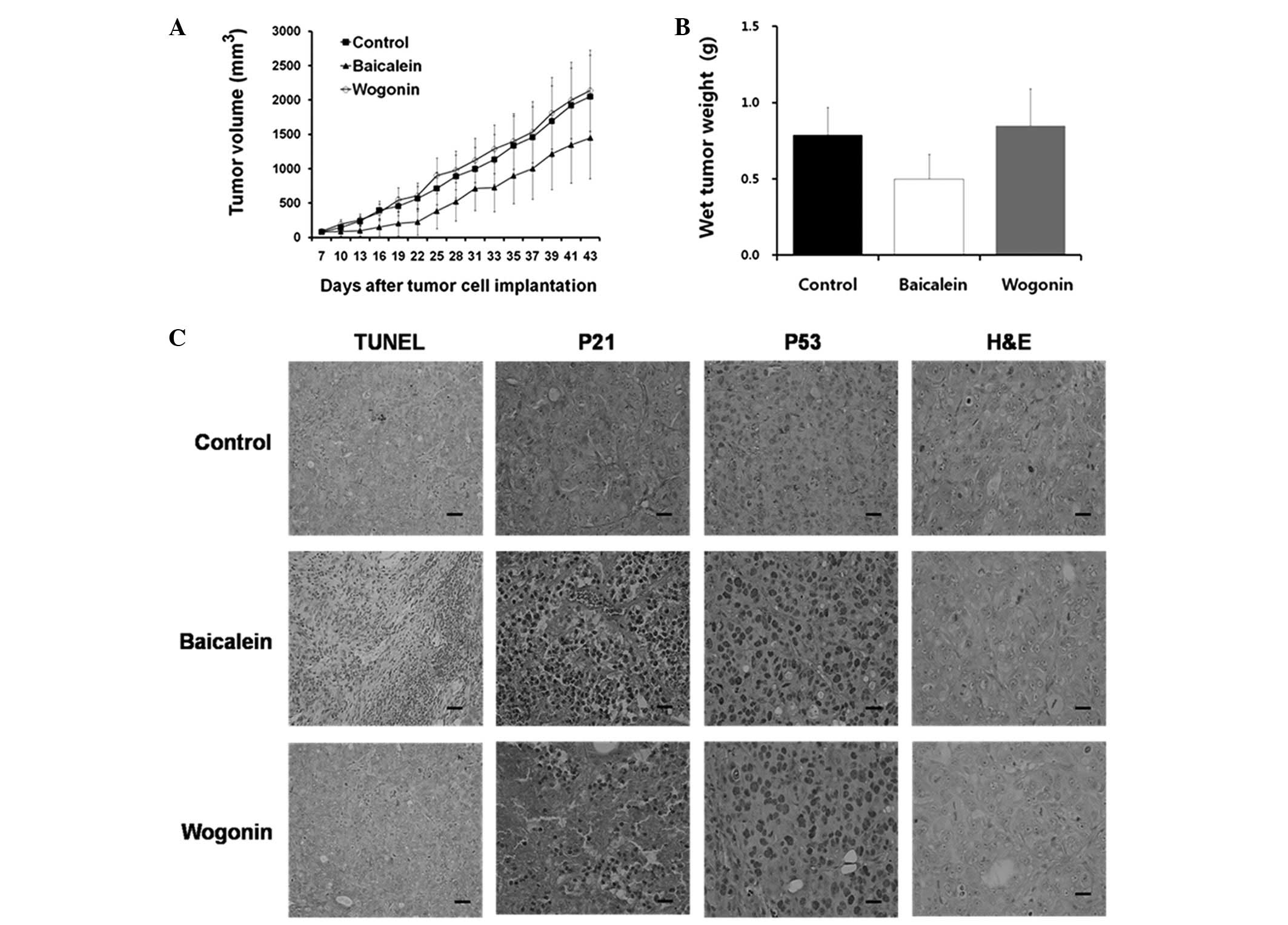|
1
|
Jemal A, Murray T, Ward E, et al: Cancer
statistics, 2005. CA Cancer J Clin. 55:10–30. 2005. View Article : Google Scholar
|
|
2
|
Samowitz WS and Slattery ML: Missense
mismatch repair gene alterations, microsatellite instability, and
hereditary nonpolyposis colorectal cancer. J Clin Oncol.
20:3178–3179. 2002.
|
|
3
|
Fang Q, Naidu KA, Naidu KA, et al:
Ascorbyl stearate inhibits cell proliferation and tumor growth in
human ovarian carcinoma cells by targeting the PI3K/AKT pathway.
Anticancer Res. 26:203–209. 2006.PubMed/NCBI
|
|
4
|
Pan MH, Chen WJ, Lin-Shiau SY, Ho CT and
Lin JK: Tangeretin induces cell-cycle G1 arrest through inhibiting
Cyclin-dependent kinases 2 and 4 activities as well as elevating
Cdk inhibitors p21 and p27 in human colorectal carcinoma cells.
Carcinogenesis. 23:1677–1684. 2002. View Article : Google Scholar
|
|
5
|
Hirano T, Abe K, Gotoh M and Oka K: Citrus
flavone tangeretin inhibits leukaemic HL-60 cell growth partially
through induction of apoptosis with less cytotoxicity on normal
nymphocytes. Br J Cancer. 72:1380–1388. 1995. View Article : Google Scholar : PubMed/NCBI
|
|
6
|
Di Carlo G, Mascolo N, Izzo AA and Capasso
F: Flavonoids: old and new aspects of a class of natural
therapeutic drugs. Life Sci. 65:337–353. 1999.PubMed/NCBI
|
|
7
|
Razina TG, Udintsev SN, Tiutrin II,
Borovskaia TG and Iaremenko KV: The role of thrombocyte aggregation
function in the mechanism of the antimetastatic action of an
extract of Baikal skullcap. Vopr Onkol. 35:331–335. 1989.(In
Russian).
|
|
8
|
Konoshima T, Kokumai M, Kozuka M, et al:
Studies on inhibitors of skin tumor promotion. XI Inhibitory
effects of flavonoids from Scutellaria baicalensis on
Epstein-Barr virus activation and their anti-tumor-promoting
activities. Chem Pharm Bull (Tokyo). 40:531–533. 1992. View Article : Google Scholar : PubMed/NCBI
|
|
9
|
Kubo M, Kimura Y, Odani T, Tani T and
Namba K: Studies on Scutellariae radix. Part II: The
antibacterial substance. Planta Med. 43:194–201. 1981.
|
|
10
|
Kubo M, Matsuda H, Tanaka M, et al:
Studies on Scutellariae radix. VII Anti-arthritic and
anti-inflammatory actions of methanolic extract and flavonoid
components from Scutellariae radix. Chem Pharm Bull (Tokyo).
32:2724–2729. 1984.
|
|
11
|
Mahmood N, Pizza C, Aquino R, et al:
Inhibition of HIV infection by flavanoids. Antiviral Res.
22:189–199. 1993. View Article : Google Scholar : PubMed/NCBI
|
|
12
|
Kyo R, Nakahata N, Sakakibara I, Kubo M
and Ohizumi Y: Baicalin and baicalein, constituents of an important
medicinal plant, inhibit intracellular Ca2+ elevation by
reducing phospholipase C activity in C6 rat glioma cells. J Pharm
Pharmacol. 50:1179–1182. 1998. View Article : Google Scholar : PubMed/NCBI
|
|
13
|
Ma Z, Otsuyama K, Liu S, et al: Baicalein,
a component of Scutellaria radix from Huang-Lian-Jie-Du-Tang
(HLJDT), leads to suppression of proliferation and induction of
apoptosis in human myeloma cells. Blood. 105:3312–3318.
2005.PubMed/NCBI
|
|
14
|
Bradford MM: A rapid and sensitive method
for the quantitation of microgram quantities of protein utilizing
the principle of protein-dye binding. Anal Biochem. 72:248–254.
1976. View Article : Google Scholar : PubMed/NCBI
|
|
15
|
Datta SR, Brunet A and Greenberg ME:
Cellular survival: a play in three Akts. Genes Dev. 13:2905–2927.
1999. View Article : Google Scholar : PubMed/NCBI
|
|
16
|
Zamaraeva MV, Sabirov RZ, Maeno E,
Ando-Akatsuka Y, Bessonova SV and Okada Y: Cells die with increased
cytosolic ATP during apoptosis: a bioluminescence study with
intracellular luciferase. Cell Death Differ. 12:1390–1397. 2005.
View Article : Google Scholar : PubMed/NCBI
|
|
17
|
Xiao D, Vogel V and Singh SV: Benzyl
isothiocyanate-induced apoptosis in human breast cancer cells is
initiated by reactive oxygen species and regulated by Bax and Bak.
Mol Cancer Ther. 5:2931–2945. 2006. View Article : Google Scholar
|
|
18
|
Zhang M, Guo R, Zhai Y and Yang D: LIGHT
sensitizes IFNgamma-mediated apoptosis of MDA-MB-231 breast cancer
cells leading to down-regulation of anti-apoptosis Bcl-2 family
members. Cancer Lett. 195:201–210. 2003. View Article : Google Scholar
|
|
19
|
Jin CY, Moon DO, Lee JD, et al:
Sulforaphane sensitizes tumor necrosis factor-related
apoptosis-inducing ligand-mediated apoptosis through
down-regulation of ERK and Akt in lung adenocarcinoma A549 cells.
Carcinogenesis. 28:1058–1066. 2007. View Article : Google Scholar
|
|
20
|
McDonald PC, Oloumi A, Mills J, et al:
Rictor and integrin-linked kinase interact and regulate Akt
phosphorylation and cancer cell survival. Cancer Res. 68:1618–1624.
2008. View Article : Google Scholar : PubMed/NCBI
|
|
21
|
Kim S, Kang J, Qiao J, Thomas RP, Evers BM
and Chung DH: Phosphatidylinositol 3-kinase inhibition
down-regulates survivin and facilitates TRAIL-mediated apoptosis in
neuroblastomas. J Pediatr Surg. 39:516–521. 2004. View Article : Google Scholar : PubMed/NCBI
|
|
22
|
Su RY, Chao Y, Chen TY, Huang DY and Lin
WW: 5-Aminoimidazole-4-carboxamide riboside sensitizes TRAIL- and
TNF{alpha}-induced cytotoxicity in colon cancer cells through
AMP-activated protein kinase signaling. Mol Cancer Ther.
6:1562–1571. 2007.PubMed/NCBI
|
|
23
|
Hwang JT, Ha J, Park IJ, et al: Apoptotic
effect of EGCG in HT-29 colon cancer cells via AMPK signal pathway.
Cancer Lett. 247:115–121. 2007. View Article : Google Scholar : PubMed/NCBI
|














